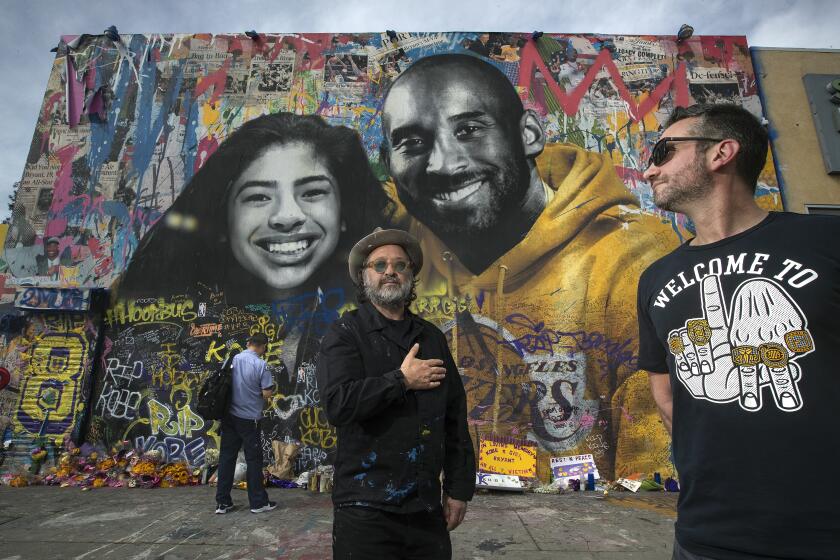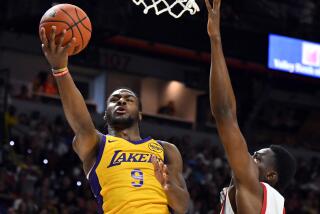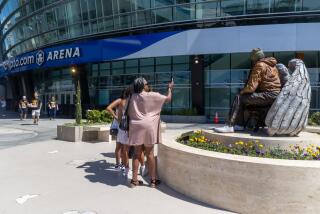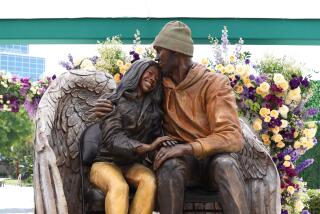Smithsonian honors Kobe Bryant’s place in history with display in Washington
- Share via
For the transformative effect he had on the sport of basketball and on American culture more broadly, the late Kobe Bryant will be remembered with a new display at the Smithsonian Institution’s National Museum of African American History and Culture in Washington.
The display — featuring a Lakers jersey that Bryant wore during the 2008 NBA Finals — was installed in the museum on the National Mall last week and will be revealed to the public for the first time Monday, said Damion Thomas, the museum’s sports curator.
“We wanted to be able to share his impact,” Thomas said. “It really is about the cultural significance of basketball as an expression of the African American fight for greater rights.”
The display, which also features other jerseys and basketball items of historic significance, further cements Bryant’s presence at the museum, which already featured his image in its Sports Gallery. Bryant and his wife, Vanessa, also helped to build the museum with a $1-million donation from their foundation.
Bryant, a Laker for 20 years and a towering figure in Los Angeles and the world of basketball, died along with his 13-year-old daughter, Gianna, and seven others in a helicopter crash in Calabasas in January. He was 41.
After his death, fans created makeshift memorials and artists painted murals all over L.A. and the world. Some in Washington paid their respects near his image in the museum’s basketball room — catching Thomas’ attention.
When Kobe Bryant, his daughter Gianna and seven others were killed in a helicopter crash on Jan. 26, artistic fans expressed their grief by creating huge tribute murals days after the Lakers’ star’s death. Ardent fan Mike Asner was so moved by what he saw, he created the @KobeMural account on Instagram to map the location of the murals, which now number 200 in Southern California alone.
The museum tries to be “responsive to the public” and to help people understand athletes “in a much larger context,” he said, and the public’s overwhelming need to mourn and remember Bryant was an opportunity.
Bryant was more than a basketball star. He entered the NBA out of high school as a guard, an unheard-of transition that changed so much about a game that had long shaped Black history in the U.S., Thomas said.
Sports were one of the first places in American society where Black talent and ability overpowered racism and where Black people felt that the American dream could be true for them, Thomas said.
Basketball, in particular, has served as a platform for Black culture, as “hair, dress, language, music also became reflected through the game,” Thomas said. Bryant — stylish on the court and off, with a beacon of a smile — was a major part of that.
After Bryant’s death, Thomas’ mind went back to a night in 2016, a week before the official opening of the museum, when curators had invited big donors and other luminaries like Bryant for a sneak peek and reception. For 45 minutes, Thomas walked Bryant through the museum, which takes visitors on a winding path through the history of slavery, the civil rights movement and the myriad ways in which Black Americans have improved the nation.
As Bryant took it all in, Thomas paused.
“I said to him that I would love to have some artifacts from his career, to tell his story,” Thomas said. “He kind of sat there and smiled and nodded his head.”
Later, the jersey arrived, along with a pair of shorts and some Nike shoes. Thomas said he chuckled when he realized the gear was from the 2008 Finals, when the Lakers lost to the Celtics, and not from 2009 or 2010, when the Lakers won the NBA title.
“As the great competitor [Bryant] was, he said, ‘I’m keeping the 2009 and the 2010!’” Thomas said with a laugh.
More to Read
Sign up for Essential California
The most important California stories and recommendations in your inbox every morning.
You may occasionally receive promotional content from the Los Angeles Times.












